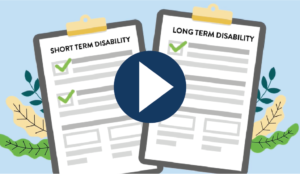Filing and securing a long-term disability claim is often a complex endeavor. This guide delves into crucial strategies and key points to consider, aiming to significantly elevate your probability of achieving a successful claim.
Understanding the Claims Process
Filing for sustained benefit assistance is a multi-faceted process that requires applicants to have a thorough understanding of several key elements. This expanded section aims to provide a detailed roadmap, guiding applicants through each step of the application process with clarity and precision.
- Eligibility Criteria: Understanding the eligibility criteria is paramount. These criteria can vary significantly based on the policy under which one is claiming and the specific nature of the impairment. It is essential to carefully review the policy terms and conditions, focusing on the definitions of eligible impairments, coverage exclusions, and any pre-existing condition clauses. This knowledge can prevent misunderstandings and streamline the application process;
- Required Documentation: The success of a claim heavily depends on providing the correct documentation. This typically includes:
- Medical Records: Detailed records from healthcare providers outlining the nature, extent, and expected duration of the impairment;
- Employment History: Documentation proving employment status before the onset of the impairment, which might include pay stubs, employment contracts, and letters from employers;
- Proof of Income Loss: Evidence showing how the impairment has led to a reduction or complete loss of income. This can include recent payslips before and after the impairment, tax returns, or employer statements;
- Application Timeline and Deadlines: Navigating the timeline is crucial. Most policies have strict deadlines for submitting the initial application and supplementary documents, and for filing appeals in case of denials. It’s important to:
- Understand Key Deadlines: Identify all relevant deadlines, including the initial filing deadline, the time frame for submitting additional documentation, and the period within which to appeal a denial;
- Timely Submission: Ensure all documents are submitted well within these deadlines to avoid automatic denial or delays;
- Navigating Denials and Appeals: Understanding the process for appealing a denial is important. This includes:
- Grounds for Denial: Knowing the common reasons for claim denials can help in preparing a more robust application;
- Appeal Process: Familiarize yourself with the steps for lodging an appeal, which may include writing a formal appeal letter, providing additional documentation, or seeking legal assistance;
- Seeking Assistance: It is often beneficial to seek guidance from professionals, such as legal advisors or claims specialists, especially in complex cases. They can provide:
- Expert Advice: Offering insights into the nuances of the policy and the claims process;
- Advocacy and Representation: Assisting in the preparation of documents and representation in appeal hearings, if necessary;
- Ongoing Communication and Follow-up: Maintaining open lines of communication with the insurer and regularly following up on the claim’s status is crucial. This ensures that any requests for additional information are promptly addressed and that the claim is processed efficiently.
By following these detailed guidelines, applicants can navigate the claims process more effectively, increasing their chances of a favorable outcome. It is essential to approach each step methodically, ensuring all requirements are met and timelines are adhered to.
Gathering and Presenting Medical Evidence
The foundation of a robust application for sustained benefit assistance lies in compelling medical evidence. This evidence encompasses a wide array of documents, including comprehensive clinical statements from healthcare practitioners, which should detail the nature and extent of the impairment, its impact on the applicant’s ability to work, and the expected duration of the impairment.
Laboratory results and functional capacity evaluations are also pivotal. They provide quantifiable data that substantiate the impairment’s severity. Compiling this evidence requires meticulous attention to detail, ensuring that all relevant information is included and presented coherently and convincingly.
Navigating Insurance Company Tactics
Insurance companies often use complex strategies to challenge or reduce the validity of claims. Understanding and preparing for these tactics is crucial for applicants.
- Exhaustive Scrutiny of Medical Records: Insurance companies meticulously review medical records to find inconsistencies or pre-existing conditions that could affect the claim. Applicants should ensure that their medical documentation is thorough, accurate, and up-to-date;
- Surveillance Tactics: Insurers sometimes use surveillance to verify the severity of an impairment. Be aware that activities in public spaces may be monitored. It’s vital to consistently adhere to the limitations prescribed by healthcare providers to avoid any actions that contradict the claim;
- Questioning the Severity of the Impairment: Insurance companies may question the severity of the impairment and its impact on your ability to work. Be prepared to provide detailed evidence, such as doctor’s notes and personal testimony, to substantiate the claim’s validity;
- Consistency and Honesty: Always maintain consistency and honesty in all communications with the insurance company. Any discrepancies in your account can be used to challenge the claim;
- Avoiding Contradictory Actions: Ensure that your behavior and actions do not contradict the claim. This includes activities on social media, which are often monitored by insurance companies;
- Dealing with Requests for Additional Information: Respond promptly and accurately to requests for additional information or clarification from the insurance company;
- Understanding Policy Language: Familiarize yourself with the policy’s language and provisions to better understand the grounds on which the insurance company may challenge your claim.
Handling Subjective and Objective Evidence
Balancing subjective and objective evidence is crucial for a successful claim.
- Understanding Subjective Evidence: This includes the applicant’s account of symptoms, pain levels, and how the impairment impacts daily activities. It’s important to keep a detailed diary of symptoms and their impact on daily life, ensuring consistency and accuracy;
- Gathering Objective Evidence: Objective evidence comes from medical tests, evaluations, and doctor’s reports. It provides a medically substantiated account of the impairment. Ensure that all medical tests and evaluations are up-to-date and thoroughly documented;
- Aligning Subjective and Objective Evidence: Ensure that your account (subjective evidence) aligns with medical records (objective evidence). Discrepancies between the two can weaken the claim.
- Effective Documentation of Symptoms: Document symptoms in a way that complements medical findings. This includes noting the frequency, duration, and intensity of symptoms, and how they correlate with medical evaluations;
- Seeking Expert Opinions: In some cases, it may be beneficial to seek expert opinions to further substantiate the link between subjective symptoms and objective medical findings.
Avoiding Common Pitfalls in Your Claim
Several common pitfalls can weaken a claim:
- Incomplete Documentation: Ensure all relevant medical records, employment history, and proof of income loss are complete and submitted. Missing documents can lead to delays or denials;
- Consistency in Records and Statements: Inconsistencies in medical records or personal statements can be used to challenge the claim. Ensure all information provided is consistent and accurate;
- Adhering to Treatment Plans: Failing to follow prescribed treatment plans can be interpreted as evidence that the impairment is not as severe. Adhere strictly to all treatment recommendations from healthcare providers;
- Regular Medical Check-ups: Regularly visit healthcare providers to document the ongoing impact of the impairment. This demonstrates the continuous nature of the condition;
- Avoiding Delay in Filing: File the claim promptly. Delaying the filing process can be viewed negatively by insurance companies.
Preparing for Potential Appeals
In case of an initial denial, preparing for an appeal is essential:
- Understanding the Appeals Process: Familiarize yourself with the appeals process, including deadlines for filing an appeal and any specific procedural requirements;
- Reassessing the Claim: Thoroughly review the initial claim to identify any weaknesses or areas that require additional evidence;
- Gathering Additional Evidence: Collect additional documentation that may strengthen the claim, such as new medical evaluations, expert opinions, or further evidence of income loss;
- Analyzing the Denial Reason: Understand the reason for the initial denial to address these specific issues in the appeal;
- Constructing a Persuasive Appeal: Focus on constructing a clear and compelling argument for why the claim should be approved, based on the evidence;
- Seeking Legal Assistance: Consider consulting with a legal professional specializing in appeals to enhance the chances of success.
Conclusion and Final Thoughts
Securing approval for sustained benefit assistance is often a complex and demanding journey, requiring diligence, attention to detail, and perseverance. This guide aims to provide a comprehensive pathway, offering insights and practical advice to navigate the intricacies of the process. With the right approach and preparation, achieving a successful outcome is within reach. This guide aims to empower applicants with the knowledge and tools necessary to enhance their prospects of securing the benefits they rightfully deserve.



